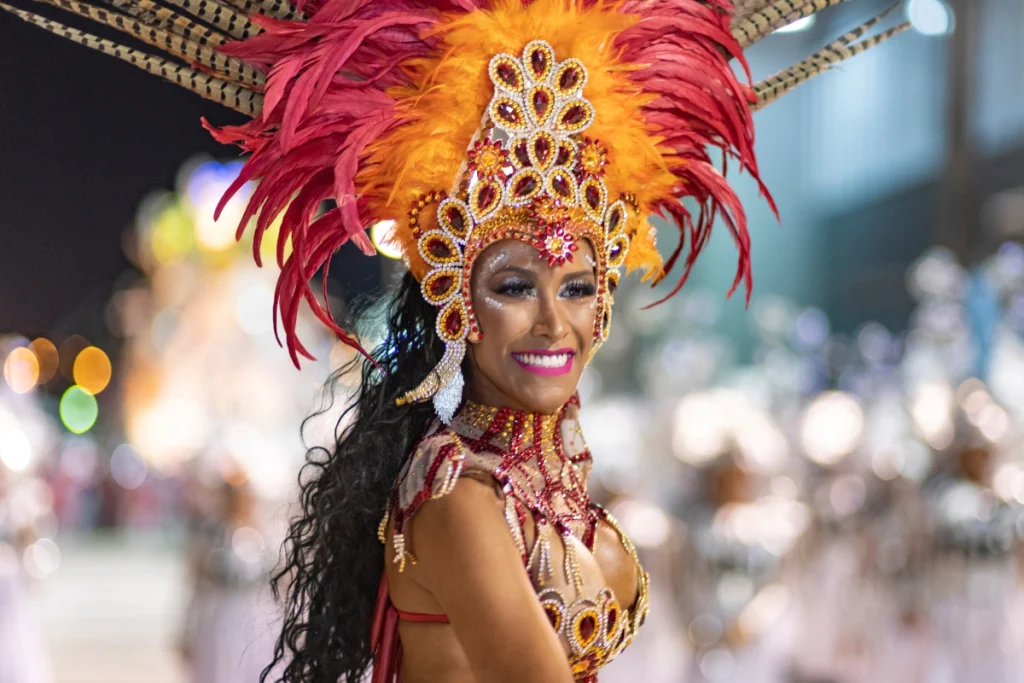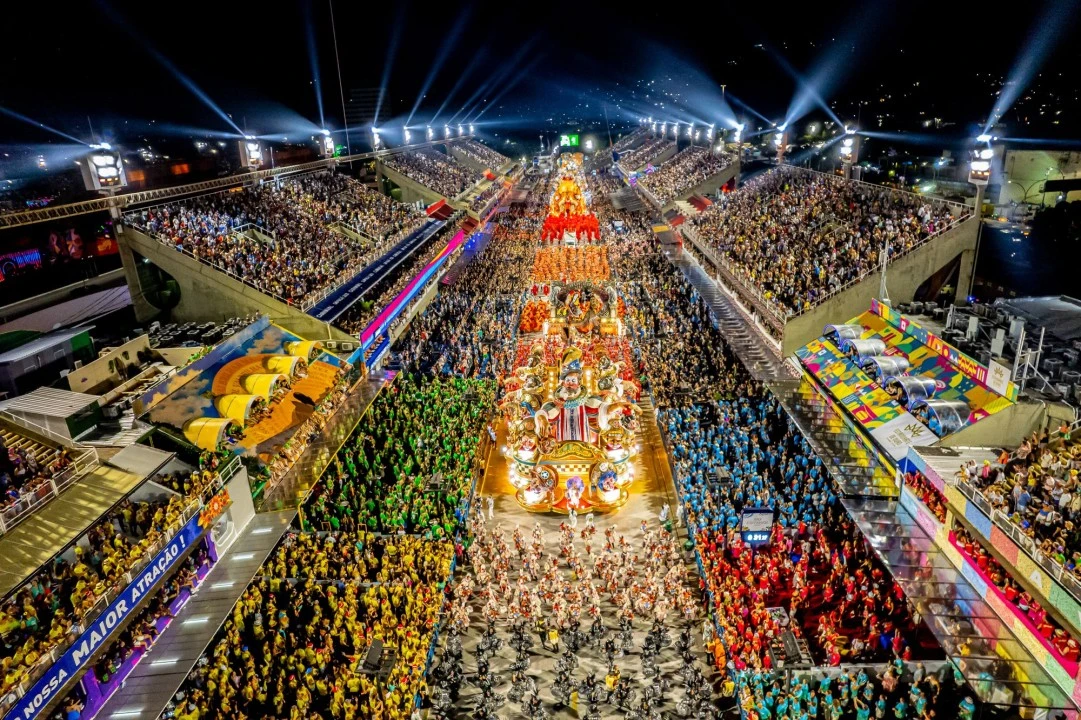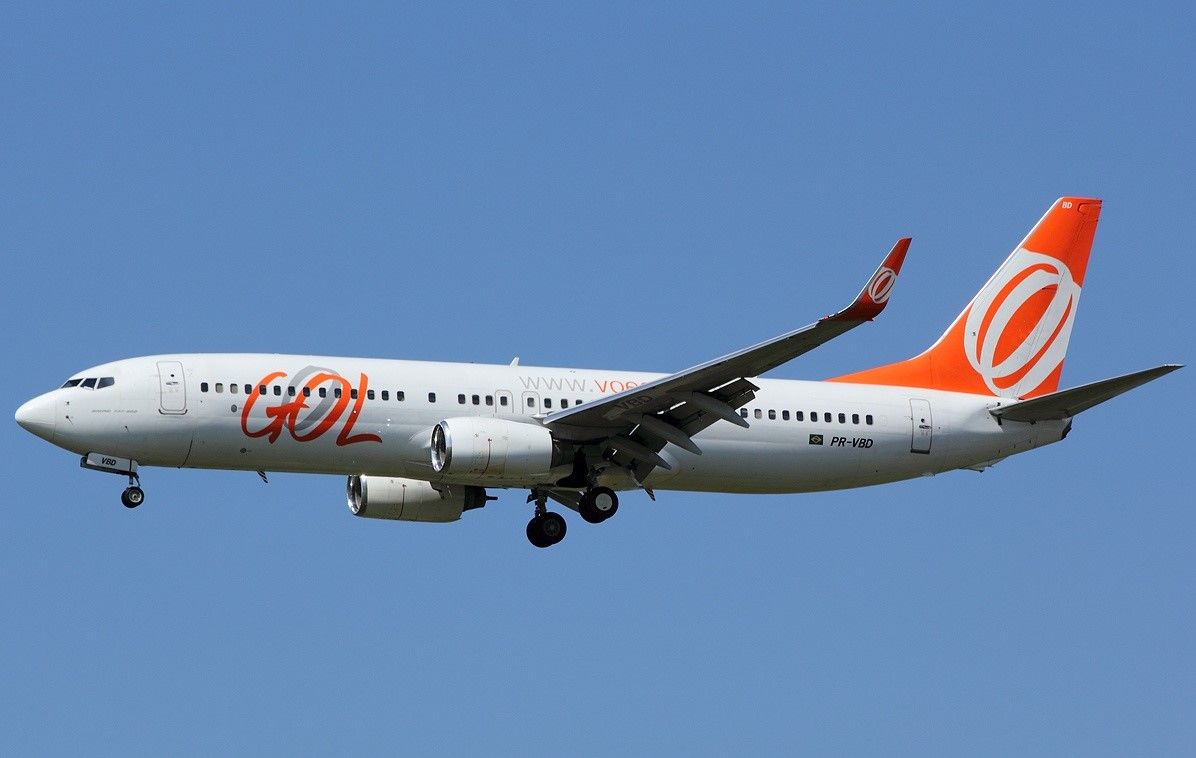Welcome to the vibrant and intoxicating world of Carnival in Rio de Janeiro – a spectacle that is larger than life and undoubtedly the biggest party on the planet. Each year, millions of people from across the globe flock to the marvelous streets of Rio to witness this iconic celebration of music, dance, and culture. With pulsating samba beats, colorful costumes, and infectious energy, it’s an experience that will leave you breathless and exhilarated.
In this article, we delve into the heart and soul of Carnival in Rio, exploring the history, traditions, and jaw-dropping spectacles that make it truly one-of-a-kind. From the elaborate parades featuring samba schools competing for glory to the mesmerizing performances of the beautiful Carnival queens, each moment is a testament to the creativity and passion that defines Rio’s carnival.
But it’s not just about the performances. We’ll also give you insider tips on how to navigate the bustling streets, where to find the best street parties (known as blocos), and where to savor the mouthwatering street food that fuels the festivities. So join us as we uncover the magic of Carnival in Rio de Janeiro and discover why this dazzling extravaganza is an experience like no other.
The History and Origins of the Carnival in Rio de Janeiro
Contents
- 1 The History and Origins of the Carnival in Rio de Janeiro
- 2 The Importance and Cultural Significance of Carnival in Rio de Janeiro
- 3 Carnival Preparations and Planning
- 4 The Carnival Parade and Samba Schools
- 5 Street Parties and Blocos
- 6 Carnival Costumes and Traditions
- 7 Top Attractions and Events During the Carnival in Rio de Janeiro
- 8 Tips for Attending the Carnival in Rio de Janeiro
- 9 Embracing the Magic of Carnival in Rio de Janeiro
- 10 Author
The roots of Carnival in Rio de Janeiro can be traced back to the 18th century, when the city was still under Portuguese colonial rule. The earliest form of the celebration was known as “entrudo,” a raucous festival that involved throwing water, flour, and even mud at one another. As the celebration grew in popularity, it evolved into a more organized and structured event, with the first official Carnival parade taking place in 1840.
Over the years, Carnival in Rio has undergone numerous transformations, reflecting the city’s rich cultural heritage and the diverse influences that have shaped it. The incorporation of samba music and dance, the emergence of the iconic samba schools, and the growing prominence of the Carnival queens have all contributed to the spectacle that we know and love today. The event has also become a powerful symbol of Brazilian identity, a celebration of the country’s vibrant and resilient spirit.
The significance of Carnival in Rio extends far beyond its entertainment value. It is a deeply rooted cultural tradition that serves as a unifying force, bringing together people from all walks of life to participate in the festivities. The event is a testament to the resilience and creativity of the Brazilian people, who have transformed a once-simple celebration into a global phenomenon that captivates audiences worldwide.

The Importance and Cultural Significance of Carnival in Rio de Janeiro
Carnival in Rio de Janeiro is more than just a party; it is a cultural phenomenon that holds immense significance for the people of Brazil. The event is a celebration of the country’s rich history, diverse heritage, and vibrant spirit, serving as a powerful expression of national identity and pride.
At the heart of Carnival lies the samba, a rhythmic and energetic music genre that has become synonymous with the festivities. Samba originated in the favelas (slums) of Rio, where it was initially embraced by the marginalized communities as a means of cultural expression and resistance. Over time, samba has evolved into a central pillar of Carnival, with samba schools (escolas de samba) competing to showcase the most elaborate and captivating performances.
The Carnival parade is a true spectacle of Brazilian culture, with each samba school representing a unique aspect of the country’s history, traditions, and values. These schools invest immense resources and creativity into the design of their costumes, floats, and choreography, vying for the coveted title of the year’s champion. The competition not only showcases the artistic talent of the participants but also serves as a platform for social commentary and the celebration of Brazilian identity.
Beyond the samba schools, Carnival in Rio is also marked by the vibrant street parties known as blocos. These lively gatherings bring together people from all walks of life, fostering a sense of community and unity that is central to the Carnival experience. The blocos are a testament to the democratization of the festivities, ensuring that the celebration remains accessible to all and that the spirit of Carnival permeates every corner of the city.
Carnival Preparations and Planning
The planning and preparation for Carnival in Rio de Janeiro is a year-round endeavor, with the samba schools and other organizers working tirelessly to ensure that the event is a resounding success. The process begins immediately after the previous Carnival, with the schools already starting to conceptualize their themes, designs, and choreography for the upcoming year.
One of the most crucial aspects of Carnival preparation is the selection of the samba school’s theme and the creation of the elaborate costumes and floats that will be showcased in the parade. This process involves the collaboration of designers, seamstresses, and artists, who work together to bring the school’s vision to life. The attention to detail is truly astounding, with each costume and float meticulously crafted to capture the essence of the chosen theme.
In addition to the samba schools, the city of Rio also plays a crucial role in the planning and organization of Carnival. The local government works closely with the samba schools and other event organizers to ensure that the necessary infrastructure is in place, including the construction of the Sambadrome – the iconic venue where the Carnival parade takes place. The city also coordinates the logistics of security, transportation, and sanitation to ensure the smooth running of the festivities.
The level of preparation and planning involved in Carnival is truly remarkable, and it is this attention to detail that makes the event such a captivating and unforgettable experience. From the intricate costumes to the flawless choreography, every aspect of Carnival in Rio is carefully crafted to create a spectacle that will leave a lasting impression on all who witness it.
The Carnival Parade and Samba Schools
The Carnival parade in Rio de Janeiro is the centerpiece of the festivities, featuring the city’s renowned samba schools competing for the coveted title of the year’s champion. The parade takes place in the Sambadrome, a purpose-built venue that can accommodate up to 90,000 spectators, making it one of the largest and most impressive stages for this cultural extravaganza.
Each samba school is a highly organized and well-rehearsed troupe, consisting of thousands of performers who work tirelessly to perfect their routines. The schools are divided into various sections, including the drumline, the dancers, the float carriers, and the Carnival queens, all of whom play a crucial role in creating the awe-inspiring spectacle that unfolds before the audience.
The parade is a true feast for the senses, with pulsating samba rhythms, vibrant costumes, and mesmerizing choreography that captivates the crowd. The schools compete against one another in a series of categories, including the quality of their music, the creativity of their costumes and floats, and the precision of their dance moves. The judges, who are experts in the art of samba, closely evaluate each performance, awarding points that ultimately determine the winner.
The Carnival parade is not just a display of artistic talent; it is also a platform for social and political commentary. The themes chosen by the samba schools often reflect the issues and concerns of the Brazilian people, ranging from the celebration of Afro-Brazilian heritage to the critique of social and economic inequalities. This fusion of entertainment and social commentary is a testament to the power of Carnival as a medium for cultural expression and community engagement.
Street Parties and Blocos
While the Carnival parade in the Sambadrome is undoubtedly the main event, the true heart and soul of the festivities can be found in the vibrant street parties known as blocos. These lively gatherings bring together people from all walks of life, creating a sense of community and unity that is central to the Carnival experience.
The blocos are characterized by their infectious energy, with pulsating samba rhythms and revelers dressed in colorful costumes dancing and singing along to the music. These street parties can be found in every corner of Rio, from the bustling city center to the quiet residential neighborhoods, each one offering a unique flavor and atmosphere.
One of the most popular and iconic blocos is the Cordão do Bola Preta, which has been a fixture of Carnival in Rio for over a century. This massive street party attracts hundreds of thousands of revelers, who come together to celebrate the city’s rich cultural heritage and the spirit of the festivities. The Cordão do Bola Preta is just one example of the countless blocos that make Carnival in Rio such a dynamic and inclusive celebration.
Beyond the music and dancing, the blocos also serve as a platform for social and political expression. Many of the street parties incorporate themes and messages that reflect the concerns and aspirations of the Brazilian people, from the celebration of Afro-Brazilian identity to the call for greater social and economic justice. This interweaving of entertainment and activism is a testament to the enduring power of Carnival as a tool for community empowerment and social change.
Carnival Costumes and Traditions
The vibrant and extravagant costumes worn by Carnival participants are a defining feature of the event, with each outfit serving as a work of art that captures the essence of the festivities. The costumes are the result of meticulous planning and craftsmanship, with teams of designers, seamstresses, and artists collaborating to create the stunning ensembles that are showcased during the Carnival parade.
The costumes are not just about aesthetics; they also hold deep cultural significance. Many of the designs draw inspiration from the rich tapestry of Brazilian history and heritage, incorporating elements that reflect the country’s diverse influences, from indigenous traditions to the legacy of African slavery. The costumes also serve as a canvas for social and political commentary, with some designs addressing issues such as environmental conservation or the fight against racial and gender-based discrimination.
Beyond the elaborate costumes, Carnival in Rio is also marked by a rich tapestry of traditions and rituals that have been passed down through generations. One such tradition is the crowning of the Carnival queen, a highly coveted title that is bestowed upon a woman who embodies the spirit and elegance of the festivities. The Carnival queens are not just beautiful; they are also ambassadors of the event, using their platform to promote the values of diversity, inclusivity, and community.
Another important tradition is the samba school’s choice of themes, which often reflect the social and political concerns of the Brazilian people. These themes are not just for show; they serve as a means of cultural expression and social commentary, allowing the participants to engage with the issues that matter most to their communities. From the celebration of Afro-Brazilian heritage to the critique of economic inequality, the themes of Carnival in Rio are a testament to the event’s enduring relevance and importance.

Top Attractions and Events During the Carnival in Rio de Janeiro
Carnival in Rio de Janeiro is a multifaceted event that offers a wealth of attractions and events for visitors to experience. Beyond the iconic Carnival parade and the vibrant street parties, there are numerous other highlights that make this celebration truly unique.
One of the must-see attractions is the Samba City, a sprawling complex that serves as the headquarters for the city’s samba schools. Here, visitors can witness the behind-the-scenes preparations for the gengtoto login, including the creation of the elaborate costumes and floats. The Samba City also houses museums and cultural exhibits that provide a deeper understanding of the history and significance of Carnival in Rio.
Another popular event is the Carnival Ball, a lavish and glamorous affair that takes place in the heart of the city. This exclusive event is a showcase of the most opulent and extravagant costumes, with the attendees vying to outshine one another in a dazzling display of fashion and elegance. The Carnival Ball is a testament to the event’s status as a global phenomenon, attracting the rich and famous from around the world.
For those seeking a more intimate and authentic Carnival experience, the Carnival Blocos offer a unique opportunity to immerse oneself in the local culture. These street parties are often organized by neighborhood communities, providing a glimpse into the everyday lives and traditions of the Brazilian people. From the lively samba rhythms to the delicious street food, the Carnival Blocos are a true celebration of the city’s vibrant spirit.
Regardless of which events or attractions one chooses to experience, Carnival in Rio de Janeiro is a truly unforgettable and immersive experience. The sheer scale and energy of the festivities, coupled with the rich cultural heritage and the welcoming spirit of the Brazilian people, make this event a must-visit for anyone seeking an unforgettable adventure.
Tips for Attending the Carnival in Rio de Janeiro
Attending Carnival in Rio de Janeiro can be an incredibly rewarding experience, but it’s also important to be prepared and informed to make the most of your visit. Here are some helpful tips to keep in mind:
- Plan ahead: Carnival in Rio is a hugely popular event, so it’s essential to book your accommodations and tickets well in advance. This will not only ensure that you have a place to stay and a spot at the events you want to attend, but it will also help you avoid the last-minute rush and potential price hikes.
- Pack wisely: The Carnival festivities can be physically demanding, so it’s important to pack comfortable clothing and shoes that will allow you to move freely and dance the night away. Don’t forget to bring sunscreen, a hat, and a lightweight jacket or shawl for the cooler evenings.
- Embrace the local culture: Immerse yourself in the local culture by learning some basic Portuguese phrases, trying the local cuisine, and engaging with the friendly and welcoming Brazilian people. This will not only enhance your overall experience but also show your respect for the host country.
- Stay safe and vigilant: While Carnival in Rio is generally a safe event, it’s important to remain vigilant and take precautions to protect yourself and your belongings. Avoid carrying large amounts of cash, keep your valuables secure, and be mindful of your surroundings, especially in crowded areas.
- Pace yourself: The Carnival festivities can be intense and overwhelming, so it’s important to pace yourself and take breaks when needed. Remember to stay hydrated, take time to rest, and don’t overindulge in the revelry to the point of exhaustion.
By following these tips and embracing the spirit of Carnival, you’ll be well on your way to an unforgettable and truly immersive experience in the vibrant and captivating world of Rio de Janeiro’s Carnival.
Embracing the Magic of Carnival in Rio de Janeiro
Carnival in Rio de Janeiro is a truly remarkable and unforgettable experience, a celebration of music, dance, and culture that captivates audiences from around the world. From the elaborate parades and samba school competitions to the vibrant street parties and mesmerizing costumes, every aspect of this event is a testament to the creativity, passion, and resilience of the Brazilian people.
But Carnival in Rio is more than just a party; it is a cultural phenomenon that holds deep significance for the country and its people. The event is a powerful expression of national identity, a celebration of the rich tapestry of Brazilian history and heritage, and a platform for social and political commentary. It is a testament to the enduring spirit of the Brazilian people, who have transformed a once-simple celebration into a global phenomenon that captivates audiences worldwide.
Whether you’re drawn to the pulsating samba beats, the dazzling costumes, or the infectious energy of the festivities, Carnival in Rio de Janeiro is an experience that will leave an indelible mark on your heart and soul. It is a celebration of life, a testament to the power of community, and a reminder of the enduring spirit of the Brazilian people. So embrace the magic of Carnival in Rio de Janeiro and become a part of this unforgettable journey.
Also read: Audi RS E-Tron GT: A Blend of Luxury, Performance, and Sustainability




